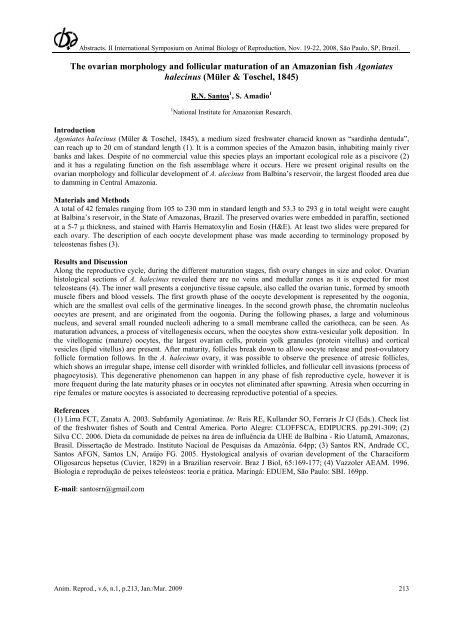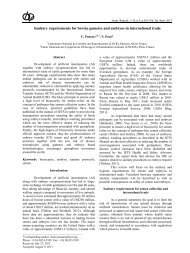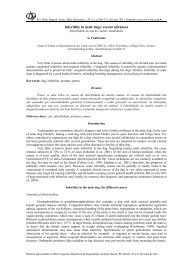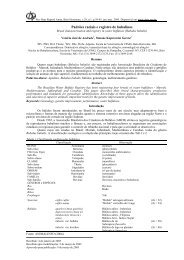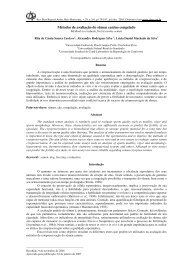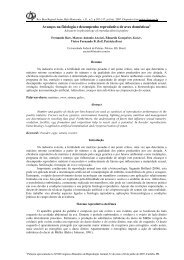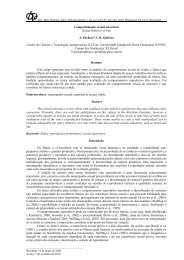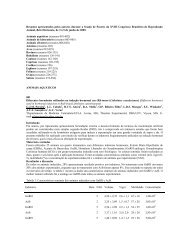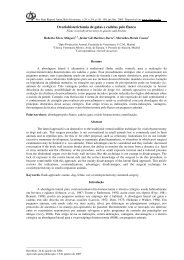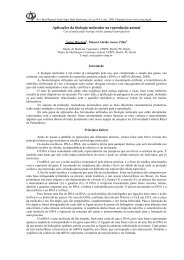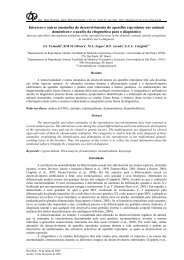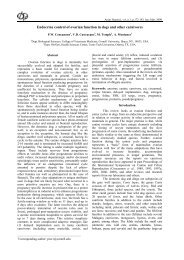Recent advances in ovulation synchronization and superovulation in ...
Recent advances in ovulation synchronization and superovulation in ...
Recent advances in ovulation synchronization and superovulation in ...
You also want an ePaper? Increase the reach of your titles
YUMPU automatically turns print PDFs into web optimized ePapers that Google loves.
Abstracts. II International Symposium on Animal Biology of Reproduction, Nov. 19-22, 2008, São Paulo, SP, Brazil.<br />
The ovarian morphology <strong>and</strong> follicular maturation of an Amazonian fish Agoniates<br />
halec<strong>in</strong>us (Müler & Toschel, 1845)<br />
R.N. Santos 1 , S. Amadio 1<br />
1 National Institute for Amazonian Research.<br />
Introduction<br />
Agoniates halec<strong>in</strong>us (Müler & Toschel, 1845), a medium sized freshwater characid known as “sard<strong>in</strong>ha dentuda”,<br />
can reach up to 20 cm of st<strong>and</strong>ard length (1). It is a common species of the Amazon bas<strong>in</strong>, <strong>in</strong>habit<strong>in</strong>g ma<strong>in</strong>ly river<br />
banks <strong>and</strong> lakes. Despite of no commercial value this species plays an important ecological role as a piscivore (2)<br />
<strong>and</strong> it has a regulat<strong>in</strong>g function on the fish assemblage where it occurs. Here we present orig<strong>in</strong>al results on the<br />
ovarian morphology <strong>and</strong> follicular development of A. alec<strong>in</strong>us from Balb<strong>in</strong>a’s reservoir, the largest flooded area due<br />
to damm<strong>in</strong>g <strong>in</strong> Central Amazonia.<br />
Materials <strong>and</strong> Methods<br />
A total of 42 females rang<strong>in</strong>g from 105 to 230 mm <strong>in</strong> st<strong>and</strong>ard length <strong>and</strong> 53.3 to 293 g <strong>in</strong> total weight were caught<br />
at Balb<strong>in</strong>a’s reservoir, <strong>in</strong> the State of Amazonas, Brazil. The preserved ovaries were embedded <strong>in</strong> paraff<strong>in</strong>, sectioned<br />
at a 5-7 μ thickness, <strong>and</strong> sta<strong>in</strong>ed with Harris Hematoxyl<strong>in</strong> <strong>and</strong> Eos<strong>in</strong> (H&E). At least two slides were prepared for<br />
each ovary. The description of each oocyte development phase was made accord<strong>in</strong>g to term<strong>in</strong>ology proposed by<br />
teleostenas fishes (3).<br />
Results <strong>and</strong> Discussion<br />
Along the reproductive cycle, dur<strong>in</strong>g the different maturation stages, fish ovary changes <strong>in</strong> size <strong>and</strong> color. Ovarian<br />
histological sections of A. halec<strong>in</strong>us revealed there are no ve<strong>in</strong>s <strong>and</strong> medullar zones as it is expected for most<br />
teleosteans (4). The <strong>in</strong>ner wall presents a conjunctive tissue capsule, also called the ovarian tunic, formed by smooth<br />
muscle fibers <strong>and</strong> blood vessels. The first growth phase of the oocyte development is represented by the oogonia,<br />
which are the smallest oval cells of the germ<strong>in</strong>ative l<strong>in</strong>eages. In the second growth phase, the chromat<strong>in</strong> nucleolus<br />
oocytes are present, <strong>and</strong> are orig<strong>in</strong>ated from the oogonia. Dur<strong>in</strong>g the follow<strong>in</strong>g phases, a large <strong>and</strong> volum<strong>in</strong>ous<br />
nucleus, <strong>and</strong> several small rounded nucleoli adher<strong>in</strong>g to a small membrane called the cariotheca, can be seen. As<br />
maturation <strong>advances</strong>, a process of vitellogenesis occurs, when the oocytes show extra-vesicular yolk deposition. In<br />
the vitellogenic (mature) oocytes, the largest ovarian cells, prote<strong>in</strong> yolk granules (prote<strong>in</strong> vitellus) <strong>and</strong> cortical<br />
vesicles (lipid vitellus) are present. After maturity, follicles break down to allow oocyte release <strong>and</strong> post-ovulatory<br />
follicle formation follows. In the A. halec<strong>in</strong>us ovary, it was possible to observe the presence of atresic follicles,<br />
which shows an irregular shape, <strong>in</strong>tense cell disorder with wr<strong>in</strong>kled follicles, <strong>and</strong> follicular cell <strong>in</strong>vasions (process of<br />
phagocytosis). This degenerative phenomenon can happen <strong>in</strong> any phase of fish reproductive cycle, however it is<br />
more frequent dur<strong>in</strong>g the late maturity phases or <strong>in</strong> oocytes not elim<strong>in</strong>ated after spawn<strong>in</strong>g. Atresia when occurr<strong>in</strong>g <strong>in</strong><br />
ripe females or mature oocytes is associated to decreas<strong>in</strong>g reproductive potential of a species.<br />
References<br />
(1) Lima FCT, Zanata A. 2003. Subfamily Agoniat<strong>in</strong>ae. In: Reis RE, Kull<strong>and</strong>er SO, Ferraris Jr CJ (Eds.). Check list<br />
of the freshwater fishes of South <strong>and</strong> Central America. Porto Alegre: CLOFFSCA, EDIPUCRS. pp.291-309; (2)<br />
Silva CC. 2006. Dieta da comunidade de peixes na área de <strong>in</strong>fluência da UHE de Balb<strong>in</strong>a - Rio Uatumã, Amazonas,<br />
Brasil. Dissertação de Mestrado. Instituto Nacioal de Pesquisas da Amazônia. 64pp; (3) Santos RN, Andrade CC,<br />
Santos AFGN, Santos LN, Araújo FG. 2005. Hystological analysis of ovarian development of the Characiform<br />
Oligosarcus hepsetus (Cuvier, 1829) <strong>in</strong> a Brazilian reservoir. Braz J Biol, 65:169-177; (4) Vazzoler AEAM. 1996.<br />
Biologia e reprodução de peixes teleósteos: teoria e prática. Mar<strong>in</strong>gá: EDUEM, São Paulo: SBI. 169pp.<br />
E-mail: santosrn@gmail.com<br />
Anim. Reprod., v.6, n.1, p.213, Jan./Mar. 2009 213


